OPC Labs - Professional OPC Development Tools
Welcome to OPC Labs! OPC Labs, an independent software vendor, develop advanced software based on OPC technology. We provide commercial off-the-shelf automation software. Our flagship OPC toolkit, QuickOPC, is a set of OPC components allowing rapid client application development using wide range of programming tools and languages.
 OPC Wizard is a software toolkit for rapid development of OPC UA servers (OPC Unified Architecture). Its aim is to allow the fully functional server be developed with minimal boilerplate code and programming effort. Intricacies of OPC UA standard are handled by the OPC Wizard internally, and hidden from the developer.
OPC Wizard is a software toolkit for rapid development of OPC UA servers (OPC Unified Architecture). Its aim is to allow the fully functional server be developed with minimal boilerplate code and programming effort. Intricacies of OPC UA standard are handled by the OPC Wizard internally, and hidden from the developer.
The toolkit provides system integrators, OEMs and software developers with ability to create their own OPC UA servers without having to learn and implement the thousands of pages of OPC UA specifications.
QuickOPC is a radically new approach to access OPC data. It is an ideal tool for integrating OPC connectivity into custom applications, or publishing OPC data on the web.
QuickOPC gives unbelievably short code to access OPC data and events. In addition, using complex heuristic algorithms to optimize itself on the fly, QuickOPC provides the most efficient, fastest access to the OPC data.
 The Excel Connector product allows you to set up a communication link between Excel and any OPC server.
The Excel Connector product allows you to set up a communication link between Excel and any OPC server.
It is possible to subscribe to and view real-time data, and also write the data back. No programming, macros or add-ins are necessary. With just drag-and-drop or copy-and-paste, you can create Microsoft Excel sheets with live, animated OPC data.
PicoOPC is a smallest imaginable OPC Unified Architecture (OPC UA) client library. It works with any .NET 6+ conformant runtime. PicoOPC does not depend on any OPC UA stack.
With PicoOPC, you can create and close sessions (opc.tcp), and perform reads and writes, synchronously or asynchronously.
Featured Product: QuickOPC
With QuickOPC, you can forget pages of complicated code and get results with a few lines of code using a programming tool and language of your choice. Benefits...
The simple code below (in C# language) reads and displays an item value, using QuickOPC in .NET:
// Read item value and display it in a message box
MessageBox.Show(EasyDAClient.SharedInstance.ReadItemValue(
"", "OPCLabs.KitServer.2", "Demo.Single").ToString());
The code below subscribes to changes of an item, and displays the value with each change:
// The callback is a lambda expression that displays the value
EasyDAClient.SharedInstance.SubscribeItem(
"", "OPCLabs.KitServer.2", "Demo.Single", 1000,
(_, args) => Console.WriteLine(args.Vtq.Value));
No other product can do this in such a clear and concise code, in a single statement! The programming is straightforward, and the developer can focus on getting the work done and not on fighting the intricacies of OPC protocols.
The same code simplicity is maintained in other programming languages. Click the link to explore the corresponding examples in Visual Basic (VB.NET).
News and Announcements
OPC Studio 2025.1 Released +
We have released OPC Studio (QuickOPC, OPC Wizard and Excel Connector) 2025.1 today. Applications built with this version can now make use of Elliptic Curve Cryptography (ECC) for OPC UA certificates and secure communication. Supported new security policies are ECC_nistP256, ECC_nistP384, ECC_brainpoolP256r1 and ECC_brainpoolP384r1.
Version 2025.1 also adds support for .NET 9.
For more information about this version, see What's new in OPC Studio 2025.1 .
OPC Studio 2024.2 Released +
We have released OPC Studio (QuickOPC, OPC Wizard and Excel Connector) 2024.2 today. This version adds a brand new product to the family: OPC Wizard, a toolkit for rapid development of OPC UA servers. OPC Wizard allows to develop a fully functional server with minimal boilerplate code and programming effort.
This version also brings various other improvements, especially in the area of user authentication in QuickOPC.
For more information about this version, see What's new in OPC Studio 2024.2 .
OPC Studio 2024.1 Released +
We have released OPC Studio (QuickOPC and Excel Connector) 2024.1 today. This version now officially supports Python not only for Windows, but also for Linux.
In OPC UA PubSub, QuickOPC now supports the standard MQTT topic tree, introduced in version 1.05.03 of OPC UA specification (the data, metadata and status topics)
We have also added approx. 100 examples in VB.NET!
For more information, see What's new in OPC Studio 2024.1 .
OPC Labs PubSub tools in use by Airbus Defence and Space +
We were pleased to learn that our customer Airbus Defence and Space is successfully using OPC Labs tools to verify and inspect the OPC UA PubSub connectivity.
QuickOPC 2023.2 Released +
We have released QuickOPC 2023.2 today. This version now officially supports Python (with help of the Python.NET library) on Windows, and PyCharm as a development environment (other Python IDEs can be used as well). More than 270 examples in Python are included!
In runtime, all user interface features (such as controls, dialogs, and live binding; Windows Forms and WPF) are now supported under .NET 6+.
For more information, see What's new in QuickOPC 2023.2 .
QuickOPC 2023.1 Released +
We have released QuickOPC 2023.1 today. This version brings many improvements in the area of OPC UA administration and PKI (certificate and trust handling, OPC UA administration dialog, and more).
For more information, see What's new in QuickOPC 2023.1 .
QuickOPC 2022.2 Released +
We have released QuickOPC 2022.2 today. This new version brings mainly changes in packaging, and various tool improvements.
For more information, see What's new in QuickOPC 2022.2 .
QuickOPC 2022.1 Released +
We have released QuickOPC 2022.1 today. This new version brings in initial support for .NET 6.0, COM management updates (for Microsoft DCOM hardening changes), and much more.
For more information, see What's new in QuickOPC 2022.1 .
OPC Certification
 QuickOPC (by the means of its Connectivity Explorer application) is certified for compliance by OPC Foundation Certification Testing Laboratory. For OPC Unified Architecture, it is the first product of its kind (.NET-based client toolkit) that has been awarded this certification.
QuickOPC (by the means of its Connectivity Explorer application) is certified for compliance by OPC Foundation Certification Testing Laboratory. For OPC Unified Architecture, it is the first product of its kind (.NET-based client toolkit) that has been awarded this certification.



